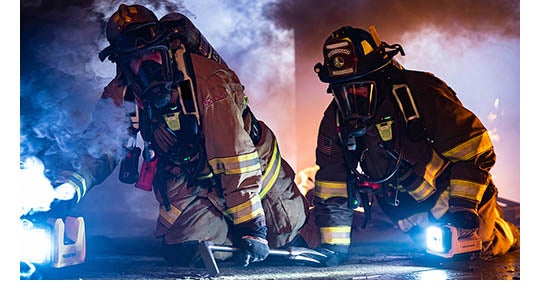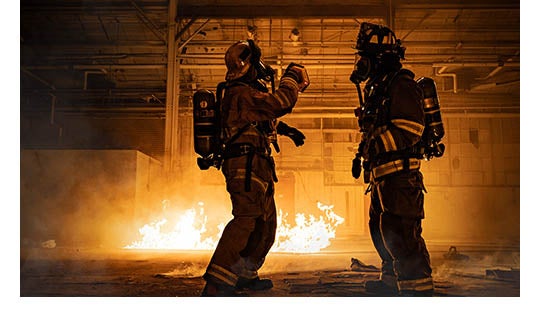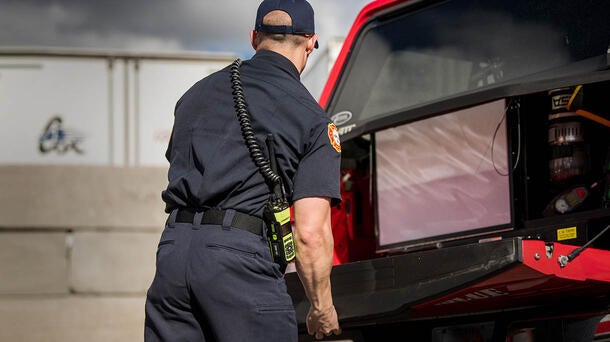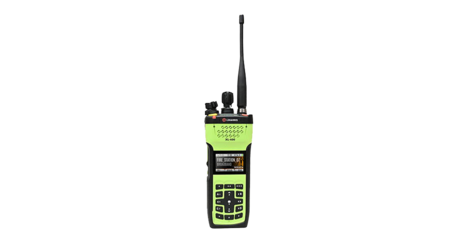As the product manager for one of the first NFPA 1802-compliant portable radio systems, I spent several years with firefighters listening to their concerns and understanding their issues.
A short time ago, I was asked, “So what are you going to do now that you’re done making the radios and mics?”
I explained that having a device was just the start – the communication device is just the foundation on which to build an ecosystem.
Today’s communication equipment is capable of more than just transmitting and receiving voice. With digital waveforms like P25 over broadband and Mission-Critical Push-To-Talk, radios are now able to send large amounts of data in addition to voice communications.
Most of today’s radios have embedded GPS, Bluetooth and Wi-Fi – and a few also have LTE capability. That is quite a lot of power in the palm of your hands or, rather, in your communications pocket.
Revolutionizing On-Scene Communications
One of the issues that firefighters have is firefighter-to-firefighter, on-scene communications.

A couple of years ago, I had one of our audio engineers with me at a burn house training exercise, and as we watched the activity, we noticed two fighters grabbing each other by their turnout coats. The audio engineer wondered out loud, “What are they doing in there?”
I knew that they were talking.
Firefighter 1 would pull at the upper sleeve of firefighter 2; he then would position his ear up against Firefighter 2’s self-contained breathing apparatus (SCBA) near the audio amplifier, so he could hear what Firefighter 2 was saying. Then they reversed that operation so that Firefighter 2 could hear what Firefighter 1’s response was.
When the exercise was over, the audio engineer asked them in disbelief if that was truly how they “talk” to each other during this critical event.
They said, “Yeah, man – we were talking.”
That event led to expanding the role of a radio to a personal public address system.
A simple and elegant solution to improving on-scene communications.
You see, like I mentioned earlier, most radios have Bluetooth capability, and today many SCBA masks also have a Bluetooth microphone embedded into the mask.
The Bluetooth mic within the mask transmits clear audio when the user presses the Push-to-Talk (PTT) on the Remote Speaker Microphone (RSM) attached to their turnout coat.
Rather than use the microphone within the RSM, the radio uses the in-mask microphone to pass audio over the Bluetooth link to the radio and, ultimately, over the air to dispatch and the team.
The audio engineer returned home wondering how he could use the technology that firefighters already had to improve their on-scene team, non-radio communications. His answer was to replace the low-power audio emitted from the voice amp with something more powerful. This led to a personal Public Address (PA) system on each firefighter.
Using the same “personal PS system,” radios send all in-mask audio out over the RSM whenever the firefighter is talking. In other words, if the Interior Fire Attack Team press their PTT, the in-mask audio is heard loud and clear by the other nearby team members over the exposed RSM. Ingeniously, this PA function mutes to receive live traffic.
It is incredible what innovations come from listening and watching end users do their job day to day!
Consider the potential for creating additional “hands-free and operator-free” capabilities using the technology already contained in today’s communication devices?
The Power of Wi-Fi
Some radios already have the ability to stream Thermal Imaging Camera (TIC) data out to Incident Command (IC) or Safety Officers (SO) – or, really, anyone who needs this data.
Recently, TIC manufacturers started adding Wi-Fi capability to the TIC. When you connect your Wi-Fi to a radio equipped with LTE, the TIC data passes through the radio over a Public Safety LTE network out to any authorized device connected to the network.
Now, in addition to the verbal descriptions from the TIC operator in the building, IC or SO can see the image displayed on the TIC. This added Situational Awareness (SA) may increase the response to the incident by providing additional actionable data for the exterior team.
As a product manager, my goal is to create devices that not only address pain points users know they have but also address pain points they have but didn’t know.
It’s been my honor to have met with many Fire Chiefs at IAFC events over the past several years. The one thing that has stood out to me and really hit me hard was learning that sudden cardiac death is consistently the leading cause of on-duty deaths.
Solving Old Problems in New Ways
These cardiac deaths are mainly attributed to overexertion or physiological stress.
Firefighters rush into burning structures, rescuing families and property, while putting themselves in danger from extreme heat and enormous physical stress.

Two main stresses include raising core body temperature (heat stress) and elevated heart rate (tachycardia). For teams who follow the PEAK (Preparing, Equipping, Assigning and Knowing) fire ground approach, “Knowing” includes how the team is doing physically within the hazard zone. And it’s that knowledge of capabilities and limitations of a responding department that leads to be best decision-making outcomes.
One common challenge that many agencies have tried to address is monitoring the core body temperature of firefighters while they are in a hazardous zone, as well as their heart rate recovery during their rest period after leaving the zone (resus).
It's important for firefighters to be aware of their core body temperature and recognize when it's too high. While modern turnout coats provide great insulation from external heat, prolonged exposure can still lead to heat buildup. Some firefighters have reported that they notice their ear lobes burning as a sign of excessive heat. However, even when aware of this, many are hesitant to take a break to cool down, feeling a sense of duty to continue their job.
The same goes for heart rate; while in the hazard zone, most firefighters have no idea what their heart rate is. It is only during resus that they are asked to take their pulse to ensure that, whatever the egress heart rate was, it returns to resting rate within a certain timeframe; otherwise, they are sent to get medical attention.
I now ask you to imagine a firefighter, equipped with a biometric monitor device that connects to their communication device over Bluetooth or Wi-Fi.
Without user intervention, this body-worn equipment attached to their communication device will send data over LTE to alert the incident commander or safety officer whenever that firefighter’s core body temperature or heart rate exceeds a predetermined value.
The incident commander, now armed with this critical information, can determine what actions are needed – whether it’s to ready another team to move in and remove the current team from harm’s way or an alternative plan.
This imagined capability is not outside of the realm of the communication equipment available today and may truly prevent some brave soul from paying the ultimate sacrifice.
Learn more about the L3Harris XL Extreme™ 400P, the only portable radio designed start to finish with firefighter input to be firefighter tough.


